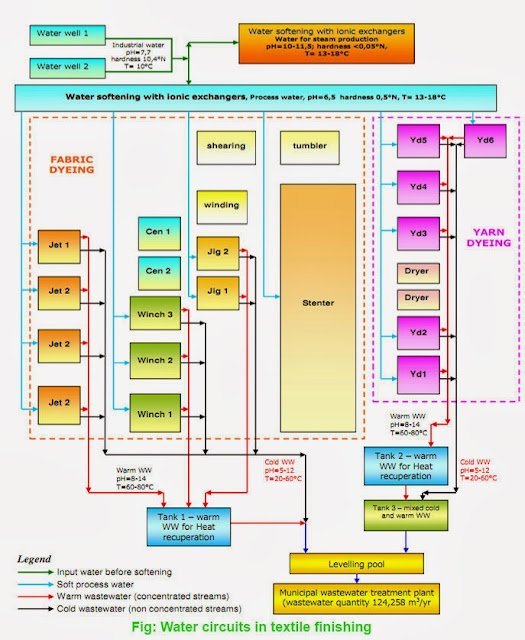Water Functions in the Textile Industry
Last updated on August 24th, 2023 at 11:51 pm
Introduction
Within the textile industry, several sectors can be distinguished. The most crucial water-consuming sector within the textile industry is the textile finishing industry. Water can be used in two different ways: a medium for textile treatment with direct contact with the material or as a heating/cooling medium without direct contact. The following figure shows a water circuit in textile finishing production.

Different Textile Processes
Wet textile finishing processes consists of operations like pre-treatment, dyeing, printing, finishing, washing, coating and laminating, carpet back coating, these operations are explained more into detail below –
You may like also: Future of Textile Manufacturing Industries
The primary water demanding processes during textile production are:
- Fabric preparation
- Dyeing
- Printing
- Special finishing
- Cooling processes
- Steam generation
- Abnormal incidents (e.g. fire protection)
- Sanitation.
Pretreatment
- Cotton (singeing, desizing, scouring, mercerizing, bleaching).
- Wool (carbonizing, washing/scouring, fulling, bleaching).
- Silk (scouring, weighting).
- Synthetic material (washing; extraction of: surfactants, complexing agents, alkali; Thermo fixation).
Dyeing
- Cellulose fibres dyeing.
- Wool dyeing.
- Polyamide fibres dyeing.
- PES fibres dyeing.
- Acrylic fibres dyeing.
Printing
- Printing with pigments.
- Printing with dyes.
Finishing (functional finishing)
- Easy care treatments.
- Water repellent treatments.
- Softening treatments.
- Flame-retardant treatments.
- Antistatic treatments.
- Mothproofing treatments.
- Bactericidal and fungicidal treatments.
- Anti-felt treatments.
- Oxidizing treatments.
- Treatments with resins.
Washing
- Washing with water (in the presence of wetting agent and detergent).
- Dry cleaning (with solvent, usually perchloroethylene).
Coating and Laminating
- The fabric to be coated/laminated is provided full width on a roll.
- The fabric is fed under careful tension control to a coating or laminating heat zone after employing the coating assistants; the fabric is passed through an oven to rectify the composite and extract volatile solvents before calming and rolling up.
Carpet back Coating
- Pre-coating
- Foam coating
- Textile back-coating
- Heavy coating
- Reinforcement
- Back finish.
Environmental Issues
Pretreatment
- Cotton: Water emissions vary according to several factors: the make-up, the sequence adopted, the fact that some treatments are often combined in a single step, etc.;
- Wool: Water emissions, but also specific operations where halogenated solvents are engaged;
- Silk: Scouring baths present a high total organic charge; the concentration of organic nitrogen components, in particular, is high. The environmental issues connected with silk pre-treatment arise from emissions of washing agents to water;
- Synthetic Material: When the material is washed, about 80 % of preparation agents are released into the wastewater. The remaining 20 % can be emitted to exhaust air in the subsequent high-temperature treatments (drying and thermo fixation).
The main concerns, as regards wastewater, arise from the discharge of poorly or non-biodegradable substances such as mineral oils, EO/PO adducts, silicone oils, complex surfactants, etc. Furthermore, biocides, usually contained in aqueous formulations, contribute to the wastewater’s aquatic toxicity.
Dyeing
- The dyes themselves (toxicity, metals, color) auxiliaries included in the dye formulation (dispersants, salts, powder-binding agents, anti-foaming agents, anti-freeze agents, thickening agents, buffer systems);
- Primary chemicals (alkali, salts, reducing and oxidizing agents) and auxiliaries employed in dyeing processes;
- Contaminants present on the fibre when it enters the process sequence (residues of pesticides on wool are encountered in loose fibre and yarn dyeing, and the same occurs with spin finishes present on synthetic fibres).
Water and energy consumption in dyeing processes are a function of the dyeing technique, operating practices, and machinery.
Printing
- Printing paste residues.
- Wastewater from wash-off and cleaning operations (unfixed dye, urea, sulfates, polysaccharides, polyacrylates, glycerine, polyvinyl alcohol, m-nitrobenzene sulphonate, multiple-substituted aromatic amines, mineral oils).
- Volatile organic compounds from drying and fixing (aliphatic hydrocarbons, methanol, polyglycols, formaldehyde, ammonia, phenyl cyclohexane).
Finishing (functional finishing)
- Ethylene urea and melamine derivatives in their “not cross-linked form” (cross-linking agents in easy-care finishes).
- Oregano-phosphorous and polybrominated organic compounds (flame retardant agents).
- Polysiloxanes and derivatives (softening agents).
- Alkyphosphates and alkyl ether phosphates (antistatic agents).
- Fluor chemical repellents.
Coating and Laminating
- Coating powders;
- Coating pastes (fatty alcohols, fatty acids, fatty amines from surfactants; glycols from emulsifiers; alkylphenoles from dispersants; glycol, aliphatic hydrocarbons, n- methylpyrrolidone from hydrotropic agents; aliphatic hydrocarbons, fatty acids/salts, ammonia from foaming agents; phthalates, sulphonamides/esters ex softeners / plasticizers; acrylic acid, acrylates, ammonia, aliphatic hydrocarbons from thickeners);
- Polymer dispersions (aqueous formulations: acrylates, monomers);
- Melamine resins;
- Polymer dispersions (organic solvent-based formulations).
Carpet back Coating
- Foaming agents and stabilizers (surfactants);
- Cross-linkers (sulfur, but also peroxides);
- Vulcanization accelerators (mercaptobenzothiazoles, dithiocarbamates);
- Activators (combination of ZnO and stearic acid);
- Gelling agent (ammonium acetate, silicon fluoride);
- Hydrophobic substances (paraffin dispersions, silicone emulsions);
- Complexing agents (EDTA, polyphosphates);
- Antioxidants;
- Thickeners (organic polymers based on polyacrylates and cellulose).
Washing
- Anionic and non-ionic surfactants;
- Impurities from the material.
You may also like: Process Flowchart of Effluent Treatment Plant (ETP)



Important article….Thanks